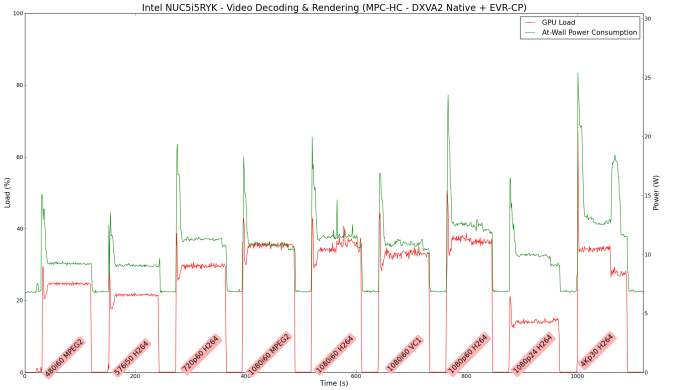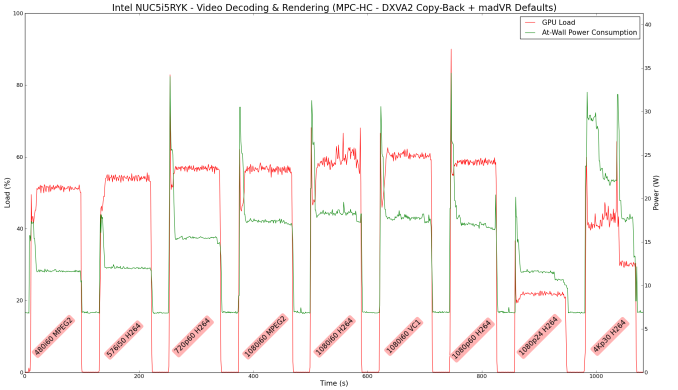Intel NUC5i5RYK Review: A Broadwell-U UCFF PC for Enthusiasts
by Ganesh T S on February 20, 2015 8:00 AM ESTHTPC Credentials
The NUC5i5RYK is a UCFF PC, but, thanks to the 15W TDP CPU inside, it doesn't require a noisy thermal solution. Subjectively speaking, the unit is silent for most common HTPC use-cases. Only under heavy CPU / GPU loading does the fan become audible. In our investigation, recent software improvements in the software chain for playback on Windows have lightened the stress considerably. The NUC5i5RYK definitely makes a good HTPC for folks who don't want to pay the premium for a passively cooled system.
Refresh Rate Accurancy
Starting with Haswell, Intel, AMD and NVIDIA have been on par with respect to display refresh rate accuracy. The most important refresh rate for videophiles is obviously 23.976 Hz (the 23 Hz setting). As expected, the Intel NUC5i5RYK has no trouble with refreshing the display appropriately in this setting.
The gallery below presents some of the other refresh rates that we tested out. The first statistic in madVR's OSD indicates the display refresh rate.
Network Streaming Efficiency
Evaluation of OTT playback efficiency was done by playing back our standard YouTube test stream and five minutes from our standard Netflix test title. Using HTML5, the YouTube stream plays back a 720p encoding. Since YouTube now defaults to HTML5 for video playback, we have stopped evaluating Adobe Flash acceleration. Note that only NVIDIA exposes GPU and VPU loads separately. Both Intel and AMD bundle the decoder load along with the GPU load. The following two graphs show the power consumption at the wall for playback of the HTML5 stream in Mozilla Firefox (v 35.0.1).

GPU load was around 13.46% for the YouTube HTML5 stream and 2.92% for the steady state 6 Mbps Netflix streaming case.
Netflix streaming evaluation was done using the Windows 8.1 Netflix app. Manual stream selection is available (Ctrl-Alt-Shift-S) and debug information / statistics can also be viewed (Ctrl-Alt-Shift-D). Statistics collected for the YouTube streaming experiment were also collected here.

For similar OTT streaming workloads, the NUC5i5RYK unit consumes slightly lower power at the wall compared to the corresponding Haswell NUC. That said, it is difficult to quantify how much of this is due to Broadwell moving down to 14nm. Other components such as the WLAN adapter, DRAM and even the power supply have changed between the two compared units. That said, the Core i5 U-based Broadwell NUC is more power-efficient for these workloads compared to the Core i7 U-based BRIX units.
Decoding and Rendering Benchmarks
In order to evaluate local file playback, we concentrate on EVR-CP and madVR using the mainstream configuration (which has the 1600 MHz DRAM). We already know that EVR works quite well even with the Intel IGP for our test streams. In our Broadwell BRIX s review, we found the HD Graphics 5500 to be incapable of downscaling 4kp30 to 1080p using default madVR settings. We didn't have much hopes for HD Graphics 6000 and our fears were confirmed when similar results were obtained with the NUC5i5RYK initially using the LAV Filters DXVA 2 Copy-Back mode in MPC-HC 1.7.8.
One of the odd aspects that we found in the course of the 4kp30 playback and downscaling process using madVR was that the GPU loading never went above 70%, but approximately half the frames were getting dropped. A careful analysis of the OSD revealed that the split queue was simply not able to keep up (with queues prior to that in the OSD being kept close to full). madVR's split queue copies the decoded frames from the GPU RAM to system RAM and then back to GPU RAM. However, this process seemed to be too slow for 4Kp30 content on the Intel IGP. Just as we were about to wrap up testing of the decoding and rendering aspects, LAV Filters 0.64 was released with huge improvements in DXVA Copy-Back performance. We repeated our benchmarks after overriding the in-built LAV filters of MPC-HC 1.7.8 with LAV Filters 0.64. 4Kp30 downscaling with madVR default settings worked without any dropped frames.
Usually, we suggest usage of the QuickSync decoder built into LAV Video Decoder whenever playback with an Intel IGP machine is desired. However, HEVC decode acceleration using DXVA (implemented partially in software) is available only in the DXVA2N and DXVA2 Copy-Back modes for Broadwell. Hence, we no longer recommend setting the default codec in LAV Video Decoder to Intel QuickSync.
In our earlier reviews, we focused on presenting the GPU loading and power consumption at the wall in a table (with problematic streams in bold). This time around, we decided to represent the GPU load and power consumption in a graph with dual Y-axes. Nine different test streams of 90 seconds each were played back with a gap of 30 seconds between each of them. The characteristics of each stream are annotated at the bottom of the graph. Note that the GPU usage is graphed in red and needs to be considered against the left axis, while the at-wall power consumption is graphed in green and needs to be considered against the right axis.
Points of concern would be GPU loading being consistently above 85 - 90%, but there is no such case in the two scenarios tested above. Power consumption at the wall is less than 15 W for even the most complicated streams when using EVR-CP, while madVR with DXVA2 Copy-Back decoding averages around 20 W for the higher complexity streams involving scaling for fast frame rate or high-resolution content.


















83 Comments
View All Comments
seanleeforever - Monday, February 23, 2015 - link
true, i suppose if your requirement is to play 4K UHD video no matter what encoding used, then you really have to step up to a faster processor.duploxxx - Monday, February 23, 2015 - link
fixed with carrizo which will launch pritty soon.StevoLincolnite - Friday, February 20, 2015 - link
I must be the only person who is still using an Atom 330 from god-knows-how-many-years-ago.It's slow and it sucks.
But with a Broadcom Crystal HD, it does *everything* I have asked of it, which is maintain my library and playback movies.
One day I will upgrade... full-fledged Windows Tablets have now hit the $100 price point, you would think I could get a full blown Atom powered HTPC for half that, right? As it doesn't include a screen? Hahaha. Wrong.
kmmatney - Friday, February 20, 2015 - link
Yeah - I just bought a Winbook 10" tablet for $149 at Microcenter. Specs: 10" IPS screen, 32GB "SSD", 2GM RAM, Win 8.1., USB and mini HDMI port. Runs movies great, and great for internet browsing, runs my programming environment, and can even run Minecraft (with optifine). I have both an Android tablet (with high density display) and an iPad4, and I can't really say the display on the Winbook as any worse - pixel size is fine. I ended up selling my Android tablet, and would sell my iPad if the rest of the family would let me. This $149 tablet blows them both away. It could easily be an HTPC with a blue tooth keyboard and mouse. It's doesn't compare to a Core i5 in speed, but it's fast enough.Antronman - Friday, February 20, 2015 - link
A $728 dollar build is easily going to fit the A10-7850kThe only advantage the NUC poses is power draw and operation volume.
Gadgety - Friday, February 20, 2015 - link
For an HTPC which also would be used for light gaming, then I believe an AMD A8-7600 or the Carrizo version, in a passively cooled case is better than these Intel offerings. Mainly from a cost and size standpoint, as the Intel system would need a graphics card. For just movie/TV kind of usage then I believe the Intel offering handles the 23.976 better than AMD.yankeeDDL - Friday, February 20, 2015 - link
Carrizo will have full H.265 support in hardware. Usually that makes just the world of difference in terms of efficiency.BlueBlazer - Saturday, February 21, 2015 - link
But for Carrizo, does not mention support for VP9 (used by Google TV) or 10-bit H.265.Teknobug - Friday, February 20, 2015 - link
In my experience, yes and no, enough power to play videos but hardly enough umph to do anything else. I tested an A4 5000, A6 1450, A8 5545M, A10 5750M and A10 7300, the A10's run hot but has a good enough GPU for low-mid range gaming and the lower end AMD's get beat out by Celeron N28** and Pentium N3530 and even the A8 gets beat out by i3's.Samus - Friday, February 20, 2015 - link
The only downside of AMD htpc's is obviously higher power consumption. It will simply need more cooling. That may be negligible to you if a near silent fan in a quality case with proper ventilation is part of your build.I personally use a passive cooled shuttle j1900-based htpc. It has no moving parts, not even a fan. That was important to me because my TV room is dead silent... and I paid dearly for a clean amp to have no speaker hiss so having no fan noise is priceless.
People with a projector or less demanding requirements should save their money and just build an inexpensive AMD htpc.